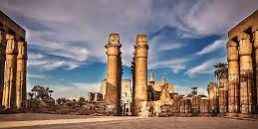Luxor, often called the world’s greatest open-air museum, is a city steeped in history and breathtaking sights. Situated on the east bank of the Nile River, Luxor was once the ancient city of Thebes, the capital of Egypt during the New Kingdom. Today, it offers travelers a treasure trove of monuments, temples, tombs, and museums that showcase thousands of years of Egyptian civilization. Whether you’re a history buff, an archaeology enthusiast, or simply a curious traveler, a Luxor Egypt tour promises unforgettable experiences. Here’s a comprehensive guide to the must-see attractions on your Luxor Egypt tours.
-
Karnak Temple Complex: The Largest Religious Site in the World
Your Luxor tour should begin with the awe-inspiring Karnak Temple Complex, a vast collection of temples, chapels, pylons, and obelisks spread over 200 acres. This monumental complex is dedicated primarily to the god Amun-Ra, but it also honors other deities and pharaohs.
Walking through Karnak, you’ll marvel at the massive hypostyle hall, featuring 134 towering columns arranged in 16 rows, each intricately carved with hieroglyphs and scenes of ancient rituals. The sheer scale of Karnak reflects the power and wealth of the pharaohs who built and expanded it over 1,500 years.
Don’t miss the Sound and Light Show in the evening, which uses dramatic lighting and narration to bring the temple’s history to life.
-
Luxor Temple: Center of Ancient Festivals
Located right in the heart of Luxor city, the Luxor Temple offers a contrasting, more intimate experience compared to Karnak. Built by Amenhotep III and later expanded by Ramses II, the temple was primarily a place of worship for the god Amun and played a central role in the annual Opet Festival, where statues of gods traveled between Karnak and Luxor temples.
As you explore Luxor Temple, notice the impressive statues, colonnades, and the beautiful carvings on the walls. The temple is especially magical at sunset, when the warm glow of the setting sun enhances the ancient stonework.
-
The Valley of the Kings: Tombs of the Pharaohs
No Luxor tour is complete without visiting the Valley of the Kings, located on the west bank of the Nile. This necropolis served as the burial ground for many New Kingdom pharaohs, including the famous Tutankhamun.
The valley is a sprawling network of tombs carved deep into the limestone cliffs, each decorated with vivid wall paintings depicting the journey to the afterlife. While there are over 60 tombs, only a selection is open to the public at any time to help preserve their delicate artwork.
Booking a guided tour here can enrich your experience, as guides explain the significance of the hieroglyphs and the mythology behind the tomb decorations.
-
Valley of the Queens: Resting Place of Royal Women
Nearby the Valley of the Kings lies the Valley of the Queens, where the wives of pharaohs and royal children were laid to rest. This quieter and less-visited site features beautifully decorated tombs, including that of Queen Nefertari, one of ancient Egypt’s most beloved queens.
The tomb of Nefertari is famed for its stunning frescoes, showcasing vibrant colors and intricate details that have survived millennia. Access is limited and often requires an additional ticket, but it’s worth the visit for those interested in royal history and ancient art.
-
Medinet Habu: The Mortuary Temple of Ramses III
Another fascinating site on the west bank is Medinet Habu, the mortuary temple of Ramses III. This temple complex is one of the best-preserved in Luxor and features massive walls adorned with battle scenes and inscriptions detailing the pharaoh’s victories.
Medinet Habu also includes a well-preserved temple of Amun and an administrative building from the New Kingdom period. Its peaceful surroundings and impressive architecture make it a rewarding stop on your Luxor tour.
-
Colossi of Memnon: Giants of Ancient Egypt
Just a short drive from the Valley of the Kings, the Colossi of Memnon are two massive stone statues depicting Pharaoh Amenhotep III seated on his throne. Standing approximately 18 meters high, these statues once guarded the entrance to a vast mortuary temple now mostly destroyed.
The Colossi are a popular photo stop and offer insight into the grandeur of royal monuments during the height of Egypt’s New Kingdom.
-
Luxor Museum: A Treasure Trove of Antiquities
For those wanting to see well-preserved artifacts without the crowds of bigger museums, the Luxor Museum on the east bank is a must. The museum houses a stunning collection of statues, jewelry, pottery, and mummies found in the Luxor region.
One highlight is the collection of artifacts from Tutankhamun’s tomb and the reconstructed Middle Kingdom tomb chapel of Nebamun, complete with detailed wall paintings. The museum’s modern layout and informative displays make it a perfect complement to your temple visits.
-
Hot Air Balloon Ride Over Luxor: A Unique Perspective
To experience Luxor from a breathtaking perspective, consider a hot air balloon ride at sunrise. Floating silently above the Nile River, temples, and desert landscape, you’ll witness the golden light illuminating the ancient monuments and lush green fields.
This serene yet exhilarating adventure is ideal for photographers and anyone seeking a memorable way to see Luxor’s beauty from the sky.
-
Explore Luxor’s West Bank Villages and Nubian Culture
Beyond the major sites, exploring local villages on the west bank of the Nile can offer a more authentic glimpse into daily life in Upper Egypt. Some tours include visits to Nubian villages, where you can experience traditional crafts, music, and hospitality.
Interacting with local communities adds cultural depth to your Luxor trip and supports sustainable tourism in the region.
-
Temple of Hatshepsut: Architectural Wonder
The Temple of Hatshepsut, near the Valley of the Kings, honors Egypt’s rare female pharaoh. Built into the cliffs, this temple features terraced levels connected by ramps and is renowned for its elegant design and vivid reliefs depicting Hatshepsut’s reign and divine birth.
Visiting this temple offers insight into one of Egypt’s most fascinating historical figures and her contributions to Egyptian architecture and politics.
Tips for Visiting Luxor’s Attractions
- Hire a knowledgeable guide: To fully appreciate the rich history and symbolism, consider hiring a licensed local guide or joining a reputable tour group.
- Wear comfortable shoes and sun protection: Most sites involve walking and exposure to the sun, so bring a hat, sunscreen, and water.
- Plan your visits early or late: Many attractions get crowded and hot during midday. Early morning or late afternoon visits are more comfortable and atmospheric.
- Respect the sites: Photography restrictions apply in some tombs and temples. Always follow rules to help preserve these ancient wonders.
Conclusion
Luxor is a city where the past comes alive in spectacular fashion. From colossal temples and royal tombs to vibrant markets and peaceful villages, it offers a diverse range of experiences for travelers. Whether you’re standing beneath the towering columns of Karnak, floating above the Nile in a balloon, or exploring the richly decorated tombs in the Valley of the Kings, Luxor’s must-see attractions promise an unforgettable journey into Egypt’s ancient heart.
If you’re planning to travel Egypt, make sure to allocate enough time to fully explore both the east and west banks of the Nile, and consider the diverse range of activities that can enrich your experience beyond sightseeing.







